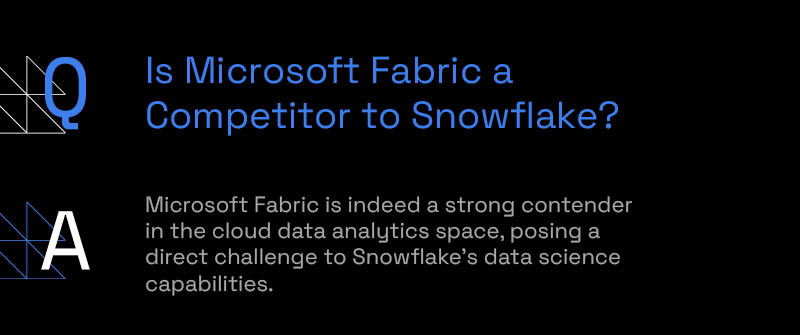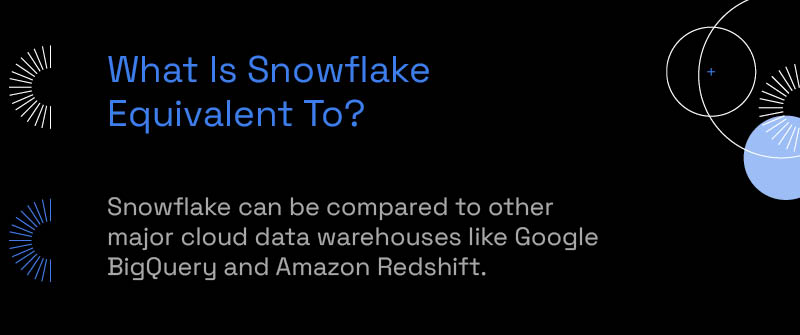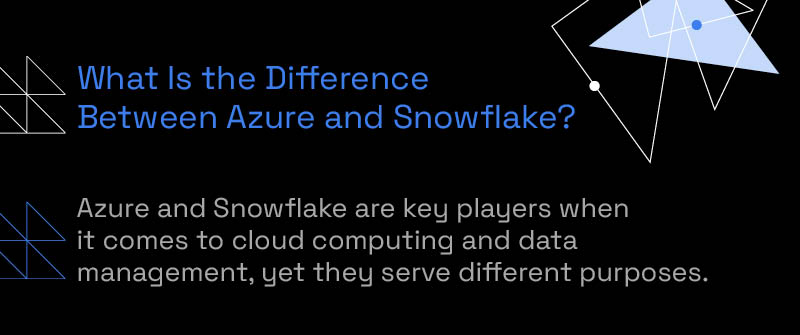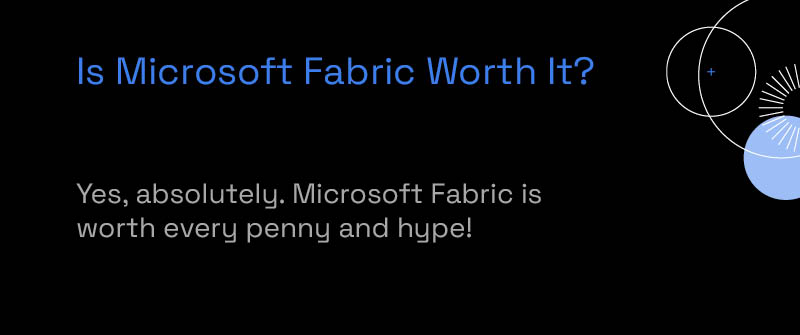
In today’s data-driven world, selecting the right cloud analytics platform is more than a technical decision—it’s a strategic move. Among the leading contenders, Microsoft Fabric and Snowflake emerge as frontrunners, each offering unique strengths to revolutionize how businesses harness data for insights and decision-making. Microsoft Fabric brings the might of Azure’s ecosystem, offering unparalleled integration and flexibility, while Snowflake impresses with its scalability and ease of use, promising to optimize data warehousing with finesse.
But how do these platforms stack up against each other? And, more importantly, which one aligns best with your business needs? This article cuts through the marketing jargon to clearly and concisely compare Microsoft Fabric and Snowflake. From architecture and performance to pricing and security, we’re here to arm you with the information you need to make an informed choice in the rapidly evolving landscape of cloud data analytics.
Prepare to dive into an exploration that demystifies these platforms, setting the stage for a data strategy that propels your business forward. Let’s get started.
Is Microsoft Fabric a Competitor to Snowflake?
Microsoft Fabric is indeed a strong contender in the cloud data analytics space, posing a direct challenge to Snowflake’s data science capabilities. While many data scientists are familiar with the Snowflake architecture, Microsoft Fabric and its architecture are designed to seamlessly integrate with various data sources, offering robust analytics and AI capabilities. This integration is a key aspect where it competes directly with Snowflake’s cloud data warehousing capabilities. This rivalry underscores the diverse strategies in the field of data analytics.
Technical Specifications and Performance Benchmarks
When it comes to choosing between Microsoft Fabric and Snowflake, understanding the nitty-gritty of technical specifications and performance benchmarks is crucial. Microsoft Fabric shines with its deep integration within the Azure ecosystem, offering seamless connectivity to various Azure services. Its architecture is designed for massive parallel processing (MPP), enabling efficient data processing and analytics across large datasets. This MPP architecture ensures that data queries are distributed across multiple nodes, significantly speeding up processing times and allowing for scalable analytics solutions.
On the other hand, Snowflake’s architecture is unique in its ability to separate storage and compute, allowing users to scale up or down on demand and pay only for the compute they use. This flexibility can lead to cost savings and performance optimization, especially for varying workloads. Snowflake also boasts automatic scaling, instant elasticity, and a shared data architecture that simplifies data sharing between Snowflake users.
Performance benchmarks between the two can vary based on the specific use case, data volume, and query complexity. However, both platforms are designed to handle large-scale data workloads efficiently. For instance, Snowflake’s ability to scale compute resources without impacting storage enables rapid query performance without the need for data movement. Meanwhile, Microsoft Fabric benefits from Azure’s global infrastructure, offering high availability and reduced latency through its global network of data centers.
Does Snowflake Support Data Fabric?
While Snowflake is primarily a cloud data platform for warehousing, it supports a data fabric-like approach by integrating various data types and sources. This functionality, although not a traditional data fabric, offers a unifying solution for data management akin to data fabric concepts.
What Is the Microsoft Equivalent of Snowflake in Azure?
Microsoft’s equivalent to Snowflake in the Azure ecosystem is Azure Synapse Analytics. This service combines enterprise data warehousing and big data analytics, offering a unified experience to ingest, prepare, manage, and serve data for immediate BI and machine learning needs. It is a powerful competitor to Snowflake, providing similar capabilities within the Azure framework.
What Is Snowflake Equivalent To?
In the broader spectrum of cloud services, Snowflake can be compared to other major cloud data warehouses like Google BigQuery and Amazon Redshift. These platforms offer similar scalability and performance capabilities, although with different pricing models and integration features. Learn more about Microsoft Fabric pricing.
What Are the Disadvantages of Snowflake?
While Snowflake has emerged as a leading cloud-based data warehousing solution, it’s important to consider its limitations alongside its strengths. These disadvantages can impact decision-making, especially for organizations weighing their options in cloud data solutions.
Pricing Concerns
One of the most significant challenges with Snowflake’s adoption is its pricing structure:
- Usage-Based Model: Snowflake operates on a usage-based pricing model. While this can be cost-effective for smaller or more sporadic workloads, costs can escalate quickly with larger datasets and more intensive query loads. This model charges for both storage and compute resources, meaning that extensive data processing or long-term data storage can lead to higher expenses.
- Predictability and Budgeting: For organizations accustomed to fixed pricing models, the variability inherent in usage-based pricing can make budgeting more complex. Predicting costs can be challenging, especially as data volume and query complexity increase.
- Optimization Required: To control costs effectively, users need to be diligent about optimizing their Snowflake environment, such as managing virtual warehouses efficiently and archiving unused data. This requires a good understanding of how Snowflake’s pricing works and constant monitoring of usage.
Learning Curve
Adopting Snowflake entails a learning curve, particularly for teams familiar with traditional SQL databases:
- New Environment Adaptation: Snowflake’s architecture, while SQL-based, differs from traditional databases in terms of data storage, compute resources, and certain SQL functions. Teams need to adapt to this new environment, which can take time and training.
- Utilizing Advanced Features: For optimal use of Snowflake, it’s crucial for users to grasp and apply its high-level functionalities, including the automatic adjustment of compute resources and the sharing of data capabilities. This might require additional training for existing staff or even hiring specialists.
Ecosystem Integration
While Snowflake has made strides in integrating with various tools and platforms, there are still areas where it can lag behind other cloud providers:
- Integration Capabilities: While Snowflake is enhancing its compatibility with external tools and services like BI tools, ETL solutions, and AI/ML platforms, its integration process may not always match the seamlessness or comprehensiveness found in other cloud providers such as AWS, Google Cloud, or Azure.
- Data Pipeline Complexity: For some organizations, especially those with complex data pipelines or those heavily invested in a particular cloud ecosystem, integrating Snowflake might require additional effort or resources to ensure smooth operation.
Security Features and Compliance
In today’s digital age, security features and compliance standards are top priorities for any organization dealing with data. Microsoft Fabric leverages Azure’s robust security framework, offering advanced security features such as network security, encryption in transit and at rest, and fine-grained access control with Azure Active Directory. Azure also complies with a broad set of international and industry-specific compliance standards, including GDPR, HIPAA, and SOC 2, ensuring that data stored in Microsoft Fabric meets stringent regulatory requirements.
Snowflake, while a standalone platform, places a strong emphasis on security and compliance as well. It provides dynamic data masking, end-to-end encryption, and role-based access control to ensure that data is securely managed and accessed. Snowflake’s architecture is built to secure data through encryption at rest and in transit, with support for customer-managed keys for an additional layer of security. Regarding compliance, Snowflake meets the standards of various compliance programs, including SOC 1 and SOC 2 Type II, PCI DSS, and more, ensuring that users can trust the platform for their data warehousing needs.
Both platforms are committed to providing a secure environment for data analytics, but the choice between them may come down to specific security requirements, integration needs with other tools and services, and existing investments in either the Azure or another cloud ecosystem.
What Is the Difference Between Azure and Snowflake?
Azure and Snowflake are key players when it comes to cloud computing and data management, yet they serve different purposes and offer unique features. Understanding their differences is crucial for organizations to decide which platform best suits their needs.
Azure: A Comprehensive Cloud Service Provider
- Extensive Service Range: Microsoft Azure goes beyond mere data warehousing, emerging as a multifaceted cloud computing platform with a wealth of services. It includes services like Azure Virtual Machines for computing needs, Azure Blob Storage for storage requirements, and a wide selection of Platform-as-a-Service (PaaS) and Software-as-a-Service (SaaS) solutions. This diverse range of services enhances Azure’s functionality, offering a more integrated and comprehensive cloud computing environment.
- Integration with Microsoft Ecosystem: Azure is seamlessly integrated with other Microsoft products and services, making it an ideal choice for businesses already using tools like Microsoft 365, Dynamics 365, or Power BI. This integration facilitates smoother workflows and data management.
- Flexibility and Scalability: Azure provides a high degree of flexibility and scalability, allowing businesses to tailor services to their specific needs. This includes the ability to choose different types of compute instances, storage options, and networking features.
- Global Network and Compliance: Azure boasts a vast global network of data centers, which ensures data residency and compliance with various regional regulations. This is particularly important for businesses with a global presence or those in regulated industries.
Snowflake: Specialized in Data Warehousing
- Emphasis on Cloud Data Warehousing: At its core, Snowflake specializes in cloud-based data warehousing. It offers a scalable and adaptable platform for the storage and analysis of substantial data volumes, making it an ideal choice for businesses heavily invested in big data analytics.
- Separation of Storage and Compute: One of Snowflake’s key features is the separation of storage and compute. This architecture allows businesses to scale storage and computing independently, optimizing performance and cost.
- Cross-Cloud Functionality: While Snowflake operates on major cloud providers (including Azure), it maintains a unique position as a cross-cloud platform. This means that businesses are not tied to a single cloud provider and can use Snowflake across different cloud environments.
- Snowflake’s Advanced Data Sharing: Snowflake stands out for its sophisticated data-sharing features, enabling secure and straightforward data exchanges between Snowflake users. This functionality is especially valuable for organizations that require collaboration with partners or clients.
To sum up, when deciding between Azure and Snowflake, it’s essential to align with your organization’s specific requirements. Azure delivers a comprehensive range of cloud services, including robust integration with Microsoft’s suite of products, which is great for companies seeking an extensive cloud computing ecosystem.
Conversely, Snowflake focuses on specialized data warehousing, offering distinct advantages like independent scaling of storage and computing resources and compatibility across different clouds. It’s particularly well-suited for businesses that prioritize cutting-edge data analytics and warehousing capabilities. The decision should be based on your organization’s specific data management requirements, existing technology stack, and long-term IT strategy.
Is Microsoft Fabric Worth It?
Yes, absolutely. Microsoft Fabric is worth every penny and hype. Don’t take our word for it; let’s see why it’s a game-changer. Find out what are the advantages of Microsoft Fabric.
- Integration and Synergy with Microsoft Ecosystem: Microsoft Fabric stands out for businesses already entrenched in the Microsoft ecosystem. Its seamless integration with a range of Microsoft services and tools, like Azure, Power BI, and Dynamics 365, can lead to significant efficiencies. This integration facilitates a streamlined workflow where data can be easily moved and transformed across various Microsoft services. For instance, data stored in Azure can be effortlessly analyzed using Power BI tools, all within the Microsoft Fabric framework. This synergy not only simplifies the data analytics process but also enhances productivity by reducing the need to switch between different platforms or tools.
- Customization and Scalability for Diverse Needs: Microsoft Fabric’s architecture is designed to be both flexible and scalable, catering to a wide range of business sizes and needs. Whether it’s a small business looking to leverage data analytics for growth or a large enterprise requiring complex data integration and real-time analytics, Microsoft Fabric can be scaled and customized accordingly. Its support for a variety of data sources and formats, combined with powerful analytics and AI capabilities, makes it a versatile tool for different business scenarios. Additionally, Microsoft’s commitment to security and compliance, especially in regulated industries, adds a layer of trust and reliability to the Fabric offering.
In essence, the decision to adopt Microsoft Fabric should be based on a thorough evaluation of your organization’s specific requirements. For businesses already leveraging Microsoft’s suite of products, Microsoft Fabric offers an integrated, efficient solution that can enhance data management and analytics processes. Its scalability and customization options mean that it can grow and adapt to your business, providing a long-term solution for data analytics needs.
However, it is essential to consider the overall investment in terms of budget and the alignment with existing infrastructure before making a decision. With its robust features and the backing of Microsoft’s technology ecosystem, Microsoft Fabric presents a promising option for businesses looking to harness the power of data analytics.
Empower Your Data Management, Data Engineering, and Data Decisions
Microsoft Fabric or Snowflake? Selecting the right platform requires a careful assessment of your organization’s unique needs, its existing technical infrastructure, and budget considerations. A clear understanding of each platform’s strengths and weaknesses is crucial in choosing the solution that best fits your data-driven objectives.
Why not let us handle the complex work for you? Reach out to us today to unlock your organization’s potential.




Your email address will not be published.